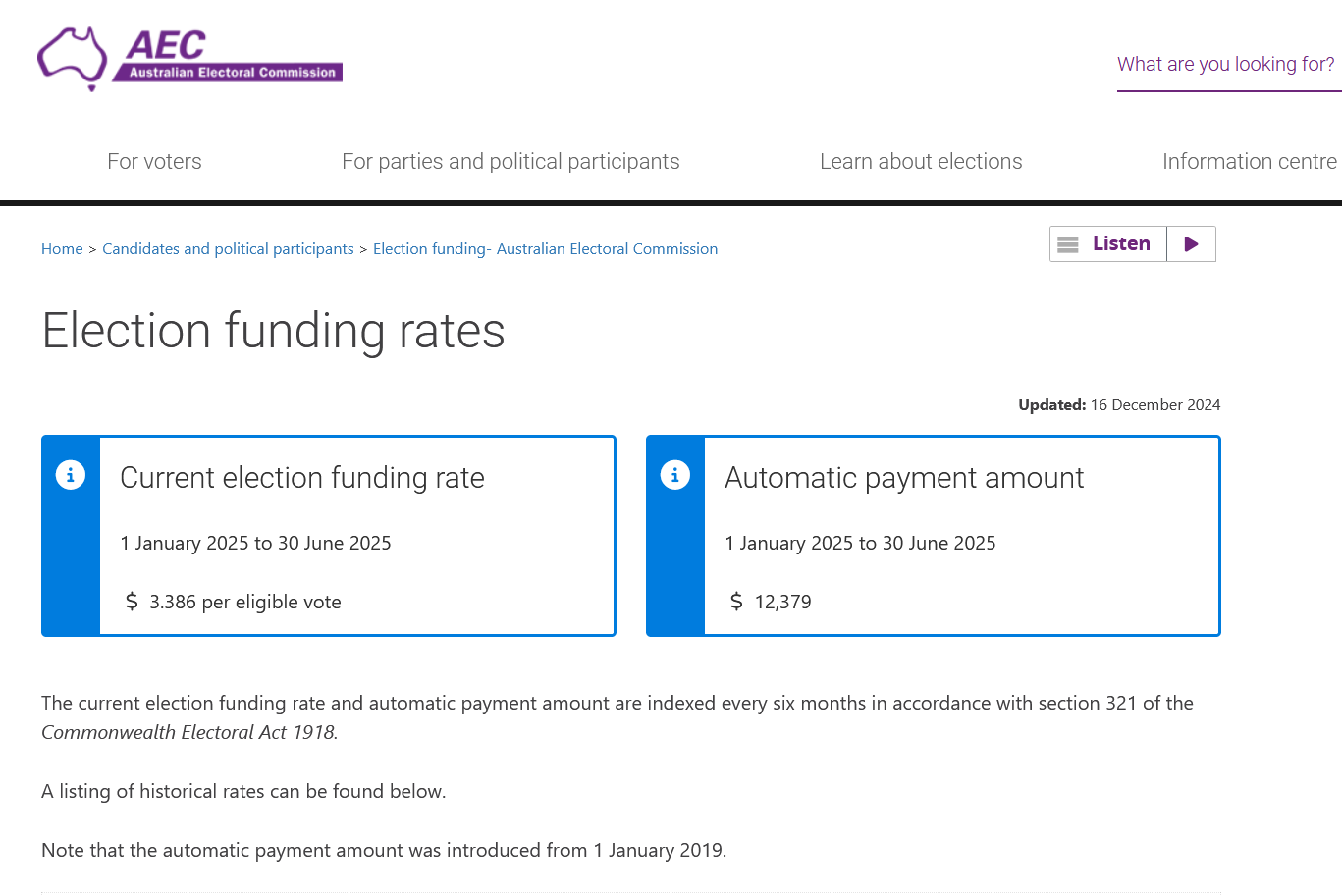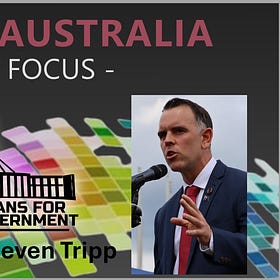Tax payer election funding! Does it benefit the entrenched major political parties?
Are smaller parties and independents disadvantaged again?
What is election funding?
Election funding is the reimbursement of electoral expenditure incurred in a federal election or by election to eligible political parties, candidates and Senate groups.
After each federal election or by-election, the AEC distributes money to eligible political parties, candidates and Senate groups to reimburse them for electoral expenditure
Who receives election funding?
Election funding is payable in relation to any candidate or group who receives at least four per cent of the total first preference votes in an election.
A registered political party is entitled to election funding when candidates it has endorsed receive at least four per cent of the formal first preference votes in an election.
An unendorsed candidate, who is not a member of a Senate group, is eligible for election funding when they receive at least four per cent of the formal first preference votes cast in an election.
Election funding is payable to an unendorsed Senate group where:
none of the group’s members have been endorsed by a registered political party; and
the group receives at least four per cent of the formal first preference votes cast in the Senate election.
Election funding rates
The funding amount is calculated by multiplying the number of first preference votes received by a rate that is adjusted every six months in line with the Consumer Price Index. For example, from January 1, 2025, to June 30, 2025, the rate is set at $3.386 per eligible vote.
I had some concerns about how this might benefit the behemoth parties like Liberal and Labor over smaller ones. So I again went to GROK
Could this system benefit larger parties over smaller parties and independents?
This per-vote funding system can indeed benefit larger parties over smaller parties and independents, and here’s how:
Volume of Votes: Larger parties, such as the Labor Party and the Liberal-National Coalition, typically attract a significantly higher number of first preference votes due to their established voter bases, broader national presence, and greater resources for campaigning. For instance, after the 2013 election, the Liberal Party received $23.9 million and the Labor Party $20.8 million in public funding, reflecting their large vote totals. Smaller parties and independents, with fewer votes, receive proportionally less funding, even if they meet the 4% threshold. This disparity amplifies the financial advantage of larger parties.
Economies of Scale: Larger parties can spread their funding across multiple candidates and campaigns, leveraging economies of scale. For example, in 2022, the Labor Party spent $116 million across 151 candidates, and the Coalition spent $131 million across 155 candidates, averaging higher per-candidate spending than the $14.4 million spent by 22 community independents combined. Smaller parties and independents, often contesting fewer seats, have less opportunity to distribute costs efficiently, making their per-vote funding less impactful.
4% Threshold Barrier: The requirement to secure at least 4% of first preference votes excludes many smaller parties and independents from receiving any public funding. While this threshold ensures funding goes to candidates with meaningful support, it disadvantages emerging parties or independents in competitive electorates where vote splitting or low visibility prevents them from reaching 4%. Larger parties, with their entrenched support, rarely face this hurdle.
Compounding Advantage: The funding received per vote feeds into future election cycles, allowing larger parties to invest in infrastructure, advertising, and voter outreach, which in turn helps them maintain or grow their vote share. Smaller parties and independents, with less funding, struggle to compete on the same scale. For example, the major parties’ ability to spend $1 million on single by-elections (e.g., Labor in Batman 2018, Liberals in Wentworth 2018) showcases their financial muscle, dwarfing the resources of most independents.
Structural Bias in Campaign Spending: While public funding is intended to level the playing field by reducing reliance on private donations, larger parties still benefit from historical accumulations of wealth and donor networks. The per-vote system supplements this advantage rather than fully offsetting it. Independents, lacking party machinery, often rely heavily on grassroots efforts, which are harder to sustain without significant funding boosts.
If you are OK with this dear reader, do nothing.
If you feel there needs to be change in our electoral processes as well as constitutional reform, you could get involved in the conversation and become a member of Australians for Better Government.
Here is recent interview with Founder and President, Steven Tripp.
Mark catches up with Steven Tripp, Founder and President of Australians For Better Government
Links Australians For Better Government
I also talked into making your vote count here.
I raised concerns about Absentee voting here.
Some questions about political parties being involved in the 'Absentee Voting' process!
A friend recently sent me through some SMS’s from the major parties, namely Liberal and Labor. Here. 👇
Click here if you’d like to buy me a coffee instead! or scan 👇
Disclaimer: All content is presented for educational and/or entertainment purposes only. Under no circumstances should it be mistaken for professional advice, nor is it at all intended to be taken as such. The contents simply reflect current newsworthy items for many varying topics that are freely available. It is subject to error and change without notice.
Neither this Substack nor any of its principals or contributors are under any obligation to update or keep current the information contained herein.
Although the information contained is derived from sources which are believed to be reliable, they cannot be guaranteed.
Disclosure: Mark Neugebauer accepts no advertising or compensation, and has no material connection to any products, brands, topics or companies mentioned anywhere on this post. However individuals on a personal level may subscribe financially to Mark’s Substack









Thank you for this informative session. Stuff the Political Parties! I Do Not Want My Hard Earn't Taxdollars Going to Any Corporate Political Party Period. No Bastidio Politician Has Ever Supported Me, Stuff Them.